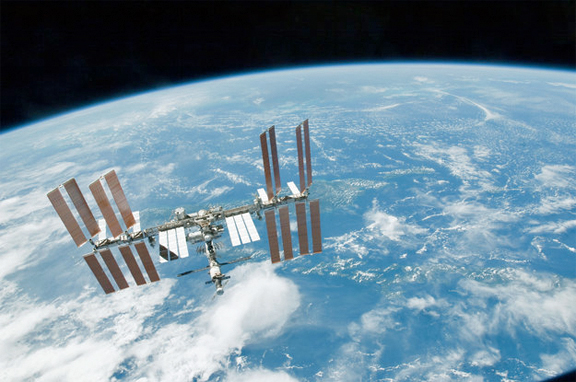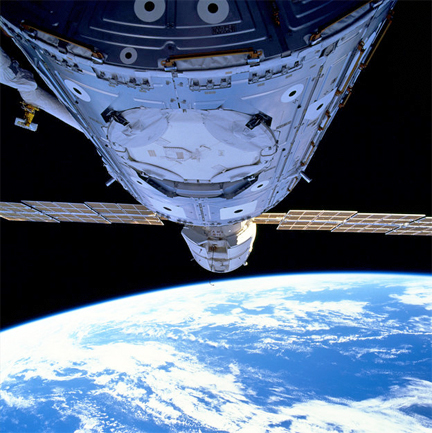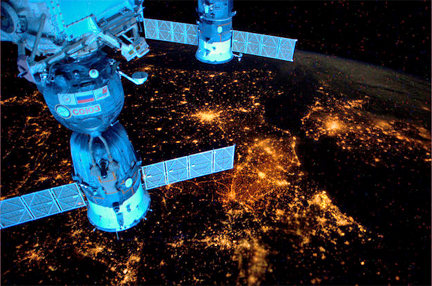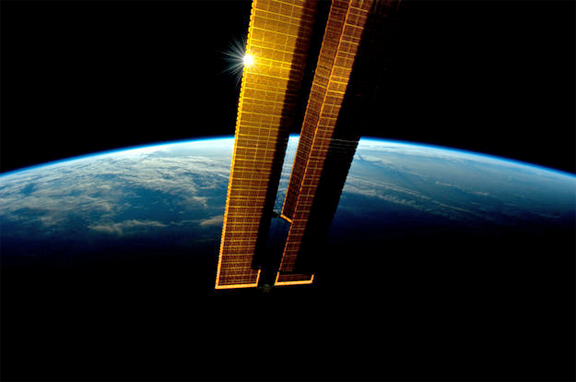
The International Space Station seen from Space ShuttleEndeavouron mission STS-130 after the spaceplane undocked on 20 February 2010.
Photo is courtesy of NASA.
The Space Station is the largest cooperative project ever carried out in science, involving NASA, ESA, Roscosmos, the Canadian Space Agency and the Japan Aerospace Exploration Agency.

The first two modules that make up the International Space Station, Zarya and Unity, docking in the cargo bay of Space ShuttleAtlantison 6 December 1998. Zarya had been orbiting Earth for 16 days before it was connected to Unity.
Since then the International Space Station has grown to include three laboratories, a gymnasium and an observatory.
Photo courtesy of NASA.
The first crew to live on the Station, Expedition 1, arrived on November2, 2000. Since then, the Station has been continuously occupied for 13 years, the longest continuous human presence in space and the only permanent weightless laboratory.
The Station has grown with the addition of the Italian-built Harmony module in 2007, ESA’s Columbus laboratory and Japanese Kibo laboratories in 2008. Since Columbus was attached to the Station almost six years ago, a total of 110 ESA-led experiments involving some 500 scientists have been conducted, spanning fluid physics, material sciences, radiation physics, the Sun, the human body, biology and astrobiology.
The Station is more than a laboratory and observatory—it is also an international space harbour receiving spacecraft such as Russia’s Soyuz and Progress, Japan’s HTV,commercial ships such as Dragon and Cygnus, and Europe’s Automated Transfer Vehicles (ATVs).
ESA has sent four ATVs packed with supplies and experiments to dock with the Space Station. The fifth, Georges Lemaître, is scheduled for liftoff next year.

Europe at night from the International Space Station by ESA astronaut André Kuipers. In frame is the Soyuz TMA-03M craft that carried him to the Station in December 2011, and a Russian Progress cargo ferry that are both docked with the International Space Station.
Photo courtesy of ESA/NASA.
The Station offers a complete orbital research and technology laboratory, and is used to test systems and operations for future space exploration. These activities improve the quality of life on Earth by increasing our scientific knowledge from out-of-this-world research.
Celebrate the Space Station’s birthday with ESA and the US, Japanese and Canadian space agencies by tweeting, using the hashtag #ISS15. What does the International Space Station—its science, technology and astronauts—mean to you.

An International Space Station solar wing catches the Sun as the orbital outpost flies over Earth as daytime arrives. This image was taken by ESA astronaut André Kuipers during his six-month PromISSe mission in 2012. Astronauts on the Station experience around 16 sunrises and sunsets each day
as they circle Earth at 28 000 km/h.
Photo is courtesy of the ESA + NASA.

